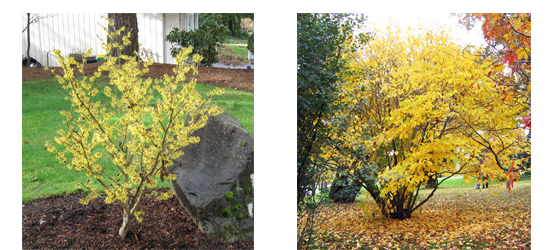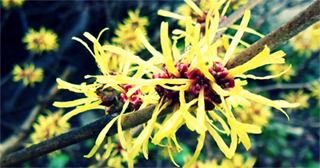Synonyms:
En: Spotted alder, winterbloom, snapping hazelnut.
Fr: hamamelis de virginie; feuilles d'hamamelis.
D: hamamelisblötter; zauberhaselblötter.
It: amamelide.
Sp: hoja de hamamelis.
Description:
Shrub or tree from 1.5m (5 ft) to 7.5m (25 ft), sometimes, although rarely, to 11m (35 ft).
Leaves; broadly oval, up to 15cm (6 ins) long, 7cm (4 ins) broad, the margin
dentate or crenate, the apex acute and the base asymmetrically
cordate when young can have a downy appearance.

When dried the lamina is papery, dark greenish brown. Vannation pinnate, very
conspicuous on the lower surface. Bark;quilled or channelled 4-15 cm (1.5-6 ins)
long and 1-2mm (1/8 in) thick.fractures fibrous and laminate. Seeds; are shiny
black externally, and white and oily within, and edible like the hazelnut common
Witch Hazel (H.Virginiana) is the only species of the genus to be a native of North America.
Where does it come from?
It grows wild on the East coast, often on hills, on stoney ground or on the banks
of streams. From New Brunswick and Nova Scotia to Florida and Texas. However,
for commercial purposes, the most prolific areas are the New England States to the
Carolinas where the abundance of plants is suited by the ideal growing conditions
of hot, dry summers, a temperate autumn and spring and cold winters.
The plant is remarkable for the late appearance of its flowers, which can be
from October to December, the leaves having fallen in late autumn.

The seeds often do not mature until the following summer and can be violently ejected,
hence the name 'snapping hazelnut'. The name Hamamelis was adopted from
the Greek to indicate its resemblance to an apple tree.
Ornamental varieties grow in asia (h. Mollis, China; h. Siebold and zucc, Japan) the
branches/twigs were formerly used as a divining rod
(witch/wych is an old English term for pliant branches).
| What can I use it for? |


|
Witch Hazel is valued for itís astringency, toning and cleansing properties and is a
prime ingredient in the international cosmetics and skin care industry.
It also has medicinal use as an astringent, an anti-haemorrhagic and an
anti-inflammatory in the treatment of Haemorrhoids.
It is used as an active ingredient in eyewash preparations Worldwide.
Historically the plant has been used by native North American Indians as a poultice for painful swellings, bruises and inflammations as well as a treatment for insect bites and burns. |
Products;
Distilled Witch Hazel BPC73/USP/NF,
Witch Hazel Distillates - non alchoholic,
Leaf Extract,
Organic Witch Hazel Distillates.
Suggested reading:
British Herbal Pharmacopeia;
Potters New Cyclopaedia of Botanical Drugs and Preparations;
The Plant Book - D.J. Mabberley;
The United States Dispensatory;
A Modern Herbal - Mrs M.Grieve;
Indian Herbology of North America. |











